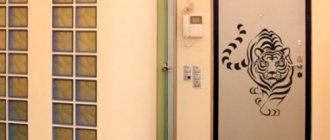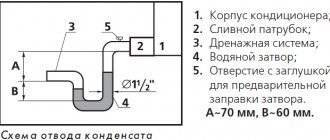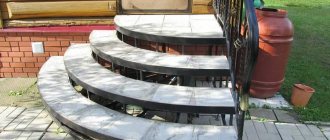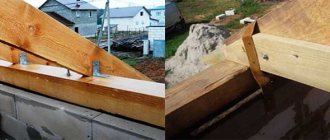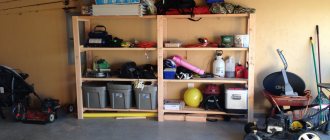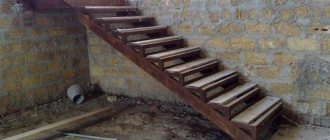If the metal entrance door sweats, then this deficiency must be eliminated. When the temperature drops due to moisture, icing of parts of the structure may occur; in addition, drops of water provoke the development of corrosion and contribute to the deterioration of the properties of the insulation if the sash has been thermally insulated. Significant deformation of the structure is noted. It is necessary to prevent the formation of condensation on the front door, because only in this case can you count on long-term operation of the door leaf.
Why does a metal door fog up?
The main factor contributing to the occurrence of this phenomenon is the temperature difference. If the air outside is cooler than indoors, and the difference is 20...30°C, then the door leaf acts as a cold bridge and drops of water form on the surface of the metal. This is due to low heat transfer resistance. For comparison, for example, walls give off heat intensively, which does not allow them to cool quickly.
With significant temperature changes, which happens in the cold season, the dew point shifts to the door leaf, because this is the thinnest section in the supporting structure of the object. When this mark is reached, moisture transitions from one state to another: from steam to water droplets. In addition, the level of humidity in the room also plays a role. The higher the value of this parameter, the more intense the conversion of moisture into water droplets will occur.
If the door leaf enters a state where it is considered a cold bridge, then the moisture contained in the air will transform into dew as it settles. In this case, the surface of the metal seems to be crying - what to do in this case? It is recommended to eliminate fogging of the front door by all means by increasing its temperature. Even if the sash is insulated, it can also become humidified when the outside air temperature drops.
Main reasons
There are several main reasons for the wet surface of a street sash:
- the front door has not been insulated, or the quality of thermal insulation is too low;
- high indoor air humidity;
- the presence of cracks in the insulated door structure: any leakage in the leaf or thermal insulation layer, an open keyhole, etc.;
- lack of insulating material under the slopes covering the doorway, or errors during their installation;
- leaks between the door frame and the opening.
If we take a more in-depth look at the reasons why the front door sweats, we need to clarify that any drafts carrying cold air from the street into the room will cool the surface of the door. When there is only one door leaf at the entrance, cold bridges are manifested by the formation of moisture on the surface of the leaf much more intensely. As a result, even if there are no errors in installing slopes/insulation on the front door, the open keyhole will allow cold air to pass through.
When there is an increase in humidity in a room, even if there is thermal insulation on the door, moisture will settle on the coolest surfaces and additionally on other objects in the room. The linen in the closets and bathroom will be dampened, dampness will appear in the room, and fungus will form on the walls. The picture will be completed by condensation on the windows and door panels.
If we take a deeper look at another reason (cracks in the insulation layer), it turns out that failure to follow installation rules also leads to the formation of water droplets on the metal. This is due to the fact that the slabs or strips of thermal insulation material must be connected with construction tape. Only in this case can the formation of cold bridges be avoided. If the insulation layer does not fit tightly against the stiffening ribs of the front door, then the risk of condensation increases, because however, not the entire metal surface is insulated.
It is important to insulate the structures adjacent to the door leaf. We are talking about slopes. This measure helps to increase the resistance of surfaces to heat loss. Thanks to this, moisture will form less intensively on the front door. Additionally, it is recommended to make sure that the door frame is well sealed. Leaks between this structure and the opening allow cold air from the street to penetrate into the room, which causes the metal surface of the front door to become moist.
Often the gap between the frame and the doorway is filled with polyurethane foam. But in these areas the material loses its properties under direct exposure to sunlight. Accordingly, the polyurethane foam ceases to perform the function of thermal insulation and sealing, as a result, cold penetrates through these places.
Installation of vestibule
This option is guaranteed to solve the problem. Even if you have an uninsulated door, condensation will stop forming. To do this, after the first metal doors, a small unheated room with a depth of at least 1 m must be made. After this, a second door is installed, it can be plastic or wooden. As a result, the first door will not heat up on one side and cool down on the other.
Healthy! For the second doors located in the vestibule, you should not use metal models, as they will release heat from the house.
This is an excellent, but rather labor-intensive option. Moreover, the design of the house does not always allow for organizing a vestibule and it is possible to install only one door. There are also several solutions for this case.
For example, it is not necessary to make such a large vestibule. You can't really turn around in such a small, cold room. Therefore, some people make a compact vestibule; they simply leave a space of about 30 cm between the metal and wooden doors. This is quite enough to create a kind of air gap.
Thanks to this principle, cold air is retained and heat does not escape through the door. Therefore, such models allow you to solve all problems at once: the appearance of condensation, icing and blowing through the door.
But you need to be prepared for the fact that the cost of such a product will be higher. In addition, if you already have one metal door installed, then it is not economical to buy a second one. In this case, it is also worth thinking about the vestibule.
Installing a door with a thermal break does not mean that you will not have to perform additional measures.
Features of operation of doors with thermal break
Although this is a fairly good method of protecting against condensation, it is additionally recommended:
- Install a canopy over the door. This will help partially cover the door from precipitation. In addition, the visor will protect against the influence of ultraviolet radiation on the canvas in the summer. If there is a 2nd floor balcony or other architectural “protrusions” above the door, then there is no need for a canopy.
- Treat the door with a special weather-resistant compound, which is an anti-corrosion primer. A cheaper option is to apply two layers of paint.
- Give preference to models coated with varnish.
And of course, it is advisable to think about possible problems at the stage of selecting and installing the product.
What dangers does condensation pose?
The likelihood that a metal door in a private house will freeze is much higher than in an apartment, where there is an air space between the entrance leaf in the entrance and the door leaf in the apartment. For this reason, special attention to this design should be given to residents of low-rise buildings.
It is a mistake to believe that moisture on the door is not dangerous. There are a number of consequences that appear in cases where condensation forms on the entrance flap:
- freezing of the canvas from the inside; if there is heavy icing, the door cannot be closed/opened until the ice is removed;
- an increase in the intensity of heat loss, which is caused by a decrease in the temperature of the door leaf and its moistening;
- deformation of the slopes, which provokes the appearance of other troubles: expansion of existing leaks between them and the wall and peeling of the insulation, which entails a general breakdown of the structure and increased intensity of condensation formation, at the same time the room becomes cooler due to increased heat loss.
Prevention is the best treatment: the difference between the front door for a house and an apartment
No matter how strange it may sound, it would be more logical to avoid problems by immediately purchasing a normal door designed to protect the room from cold and atmospheric influences.
Many people do not see the difference between the entrance doors for a house and for an apartment, and they buy, for example, an apartment door for their house, and then suffer with condensation. And this applies not only to buyers, but also to so-called sellers who advise “an excellent inexpensive option.”
Entrance doors for a house and an apartment should be similar:
- on sound insulation and tightness;
- for anti-vandal qualities and burglary resistance.
But the door for a house must be well insulated and withstand:
- low temperatures;
- ultraviolet;
- precipitation and other atmospheric phenomena.
Typically, such canvases are coated on the outside with specialized polymer-powder compositions that help insulate cold bridges and help conserve heat in the room.
The best option for a private home is a door with a thermal break. This design can be called: two in one. The essence of the thermal break is that the two sheets are not connected by metal fasteners - this eliminates cold bridges and forms a buffer zone. Thermal break is an insulating layer with low thermal conductivity that separates two sheets. A box of this design is usually also made with a thermal break.
Ways to combat the phenomenon
If iron doors fog up, it is recommended to perform a number of manipulations to eliminate this problem:
- Seal the entrance door around the perimeter of the leaf. For this, it is best to use a rubber cord. It is attached to the porch. In some door designs, the seal is installed during production. This measure will avoid the formation of drafts.
- Thermal insulation of the door leaf. Various types of insulation are used, the most popular of which are polystyrene foam and mineral wool. It is important to choose a material of suitable thickness. The joints of the strips must be connected with construction tape.
- It is recommended to close the keyhole with a special cover. This will not interfere with the operation of the locking mechanism, but will also prevent cold air from penetrating through a leak in the lock.
- Door frame seal. It is necessary to fill the space between the door frame and the entrance opening. For this purpose, polyurethane foam is used. If the material has lost its properties, it must be removed from the gap between the box and the opening and another portion of foam must be added. However, in this case, it is necessary to putty the updated areas, which will avoid loss of properties of the material.
- Insulation of door slopes. To do this, it is necessary to dismantle the slopes, secure material with thermal insulation properties, and then install them again.
- It is necessary to control the humidity level in the house. If natural circulation is not effective enough, supply and exhaust ventilation should be installed.
How to adjust a metal door if it has sagged
If the door has sagged, you can most often make the adjustment yourself. In rare cases, when deformation of the structure occurs due to poor quality of the product, you should contact specialists or customer service
When subsiding, you should pay attention to the following elements:
- loop integrity;
- presence of box deformation;
- the presence of skew of the canvas.
Adjusting the hinges
Often it is necessary to repair entrance doors whose hinges are worn out or deformed.
It is important to determine why the fittings became unusable:
- wear of elements;
- design features.
In the first case, the hinges may not be of good quality, so they wear out quickly. Or they have been used for too long and need to be replaced. In the second case, in order to save money, some manufacturers install 2 fittings instead of 3-4. If this is the problem, it is quite difficult to fix it yourself. You need to have the necessary tools and skills.
When the problem is in hinged welded hinges, subsidence is eliminated as follows:
- a washer or bearing is placed between the parts of the fittings;
- use a file or grinder to enlarge the counter hole;
- the work is carried out carefully and accurately to prevent free movement of the sash.
When hidden hinges are used in the design, due to the large weight of the fabric, the screws that perform the fixation lose their shape and the clamp weakens. It is necessary to perform the following steps for adjustment:
- purchase identical or similar hardware;
- Unscrew the top screws and lean the sash against the wall;
- replace hardware;
- repeat steps for bottom loops.
The easiest way to adjust the ball fittings. Such products have the possibility of three-vector adjustment using a special key and screwdriver. Determine the direction of the skew and tighten the corresponding screws.
Box alignment
Sometimes doors sag immediately after installation. The reason for this is often poor installation. The wedges can be driven in with such force that they bend the frame. If the anchor bolts are overtightened, the geometry of the frame is disrupted. To correct this flaw, you need the following tools:
- construction knife;
- sledgehammer with plank spacer;
- paper.
First, remove the slopes and polyurethane foam, loosen the clamp of the anchors. When the door leaf has a mirror inside, the leaf should be removed to avoid splitting. It must be lifted and placed near the opening. Use pegs to level the horizontal plane, and use a sledgehammer to level the vertical plane. A sheet of paper is inserted between the sash and the frame, and then the door is closed. If the sheet is pulled out with force, the adjustment is complete.
Additional measures to combat condensation
If the recommendations described above did not help to avoid dampening the front door, then you can consider the option of coating the door with a special powder polymer. This is a type of paint that, due to its structure and method of application, gives the coating thermal insulation properties.
If you have to consider additional measures to combat moisture on metal, you should consider installing a second door (i.e. vestibule). The advantage of this solution is to reduce heat loss. Heat leaves the room less intensively due to the air space between the doors. As a result, condensation does not form on the front door. This measure allows you to get rid of moisture on the metal surface of the outer sash, provided that other recommendations for getting rid of excess moisture are taken into account.
Recommendations from experts
So that during operation you do not have questions to the manufacturers about why condensation forms in cold weather, experts recommend taking into account the following points when placing an order:
- Separately discuss and order insulation of not only the door itself, but also the frame.
- Refuse to install a peephole in the door facing the street.
- Do not install locks with vertical bolts on such a door or do not connect drive rods in cold weather.
Soda Ash and Washing Powder
Washing powder and soda ash will help deal with yellowed plastic surfaces.
This way you can bleach small plastic items. To do this, you need to take 1 tablespoon of soda ash, the same amount of any washing powder, dissolve them in 1 liter of warm water. Soak yellowed objects in the resulting solution for 10-12 hours. After this, rub thoroughly with a sponge or napkin and wash under running water. If you need to increase the volume of water, then do not forget to maintain the proportion.
Safe chemistry
To avoid damaging the door, you need to choose a safe product that is suitable for a specific coating. Even if there are stubborn stains on the surface, undiluted acetone, abrasives, acids and solvents should not be used.
Acetone, alcohol or nail polish remover diluted in a 1:1 ratio will help remove stains from coffee, tea and other drinks.
If the door is covered with oil-based paint, the safest solution is ammonia. The proportions depend on the degree of contamination - the more old the stain, the more concentrated the solution should be. Usually it is enough to dilute 2 tsp. ammonia in 1 liter of water. A more concentrated composition will help with stubborn stains: dilute 2 tsp in 1 glass of water. alcohol
Dishwashing liquid and regular soap or shampoo are excellent for cleaning doors. To reduce foam formation, you should use special furniture cleaning products.
During cleaning, you need to ensure that the cleaning agent does not come into contact with the rubber seals.
How to clean laminated chipboard panels
There are four ways to wash stains from chipboard panels:
- Citric acid
Prepare the solution - add two tablespoons of acid to 200 ml of cold water. Mix thoroughly and wash off the stain with the resulting mixture. Wipe the treated area with a dry cloth.
- Using a solvent
A cotton pad should be moistened with solvent and carefully rinse off the greasy stain. After removal, the surface is also wiped with a clean towel.
- Detergent
Add three tablespoons of detergent to half a glass of water. Mix and apply the resulting foam to the stain. Wait 3 - 5 minutes and rinse thoroughly. Wipe dry with a clean rag.
- Baking soda
Mix three tablespoons of baking soda per glass of water. The resulting solution washes off the stain. Then the surface is wiped dry.

